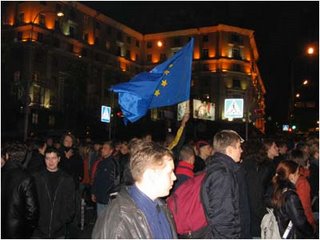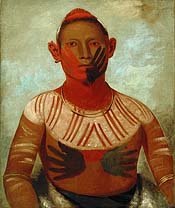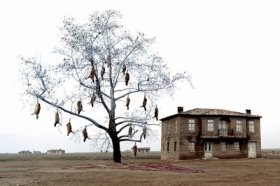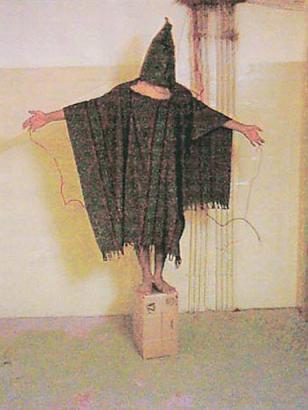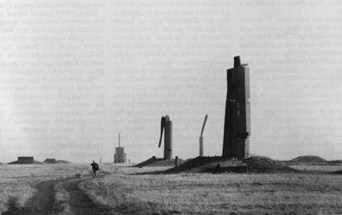Now Still Showing, Graffiti Art!! (The Late 20th Century Eclipse Of Intensely Focused Artistic Primitivism By Urban Guerrilla 'Art Stars')
On the downside, the 20 aerosol spray paintings from the early 1980's on display, including works by once-famous graffiti artists, like Daze, Crash, and Lady Pink, are negligible as works of art. And it does not help that the exhibition's designers have erected walls within the main gallery, where children are invited to create graffiti themselves.
On the other hand, though it does not go into its subject as deeply as it could have, the exhibition represents an interesting and possibly instructive sociological episode in recent art history: the story of an unusual convergence of avant-garde high culture and grass-roots youth culture, with each side bringing its own sets of values, understandings, and aspirations.
The embrace of graffiti by high culture goes back to Jean Dubuffet and Cy Twombly, whose paintings contain elements resembling anonymous signs found on public bathroom walls. The broader background is modernism's fascination with all things perceived as primitive. Picasso's appropriation of African tribal art, Paul Klee's imitation of children's art [sic], and the celebration of the self-taught painter Henri Rousseau are examples.
The kind of graffiti under consideration in the Brooklyn Museum's show is not like bathroom primitivism. The New York subway graffiti artists of the 70's worked fast in the night, using aerosol spray cans. But the mix of bold, wildly distorted lettering, luminous color and cartoon imagery betrayed a practiced understanding of illustration, design, scale and theatrical impact. It was the work of talented preprofessionals.
Graffiti still had a certain outlaw allure. It was (and still is) illegal, and the artists took real risks — of being arrested by the police (or grounded by their parents) and of physical injury — in doing the things they did. So it had a romantic attraction to high-culture people like Norman Mailer, who wrote the text for a subway graffiti photography book called "The Faith of Graffiti" in 1974.
Two developments in the late 70's conspired to bring graffiti into art galleries. One was the crackdown on graffiti in the subways by city officials; the other was the efflorescence of the scene in the East Village [Manhattan], where youthful exuberance, insouciant rebellion and spontaneity were the prevailing values, and artists like Keith Haring, Kenny Scharf and Jean-Michel Basquiat, who were or had been involved in graffiti, were major stars.
Suddenly works on canvas and paper by the ex-underground artists were showing and selling in fancy galleries in New York, Europe, and Japan. The eminent 57th Street dealer Sidney Janis put on a major exhibition of graffiti art in 1984 and bought a lot of graffiti painting too. In 1999 Mr. Janis's heirs donated about 40 graffiti paintings to the Brooklyn Museum, and it was from that group that the museum's contemporary art curator, Charlotta Kotik, selected the present show." ...
Ken Johnson "When Aerosol Outlaws Became Insiders: Graffiti Art at the Brooklyn Museum" June 30, 2006
http://www.nytimes.com/2006/06/30/arts/design/30graf.html?8dpc
*
At the Phillips Collection, Washington, D.C.
Klee and America
June 17–September 10, 2006
Swiss artist Paul Klee’s (1879–1940) remarkable work has long struck a responsive chord in America, with both collectors and artists. He was greatly admired by the abstract expressionists for his inventiveness and genius for composition. Earlier, he had a profound influence on Germany’s Bauhaus, and his work was a victim of Nazi art purges. Approximately 80 works of extraordinary quality will be on view, among them works collected by Ernest Hemingway, Clifford Odets, and Mies van der Rohe. The Phillips Collection’s 13 works by Klee, one of the cornerstones of the collection, has served as inspiration for American artists including Richard Diebenkorn, Gene Davis, and Kenneth Noland.
http://www.phillipscollection.org/html/exhibits.html
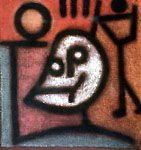
Paul Klee [1879-1940], Death and Fire, 1940
((46 x 44 cm (18 x 17 1/3 in))
Klee Foundation. Bern, Switzerland.
... "Klee grew up in a musical family and was himself a violinist. After much hesitation he chose to study art, not music, and he attended the Munich Academy in 1900. There his teacher was the popular symbolist and society painter Franz von Stuck. Klee later toured Italy (1901-02), responding enthusiastically to Early Christian and Byzantine art. ... Klee died relatively young [sic] of a slow and wasting disease, his death horribly mimicked by the death of peace that signified World War II. His last paintings are unlike any of his others. They are larger, with the forms often enclosed by a thick black line, as if Klee were protecting them against a violent outrage. The wit is gone and there is a huge sorrow, not personal, but for foolish and wilful humanity.
Death and Fire is one of Klee's last paintings. A white, gleaming skull occupies the center, with the German word for death, Tod, forming the features of its face. A minimal man walks towards death, his breast stripped of his heart, his face featureless, his body without substance. Death is his only reality, his facial features waiting there in the grave for him. But there is fire in this picture too: the sun, not yet set, rests on the earth's rim, which is also the hand of death. The upper air is luminous with fire, presenting not an alternative to death, but a deeper understanding of it. The man walks forward bravely, into the radiance, into the light. The cool, grey-green domain of death accepts the fire and offers wry comfort.
Three mysterious black stakes jag down vertically from above, and the man strikes the skull with another. If fate forces him down into the earth, he does not go passively or reluctantly: he cooperates. Death's head is only a half-circle, but the sun that it balances in its hand is a perfect globe. The sun is what endures the longest, what rises highest, what matters most, even to death itself. Klee understood his death as a movement into the deepest reality, because, as he said, ``the objective world surrounding us is not the only one possible; there are others, latent''....
Text credit: WebMuseum, Paris. With thanks.
Image credit: (c) Klee Foundation, Bern via Department of Art, University of Wisconsin. With thanks.


